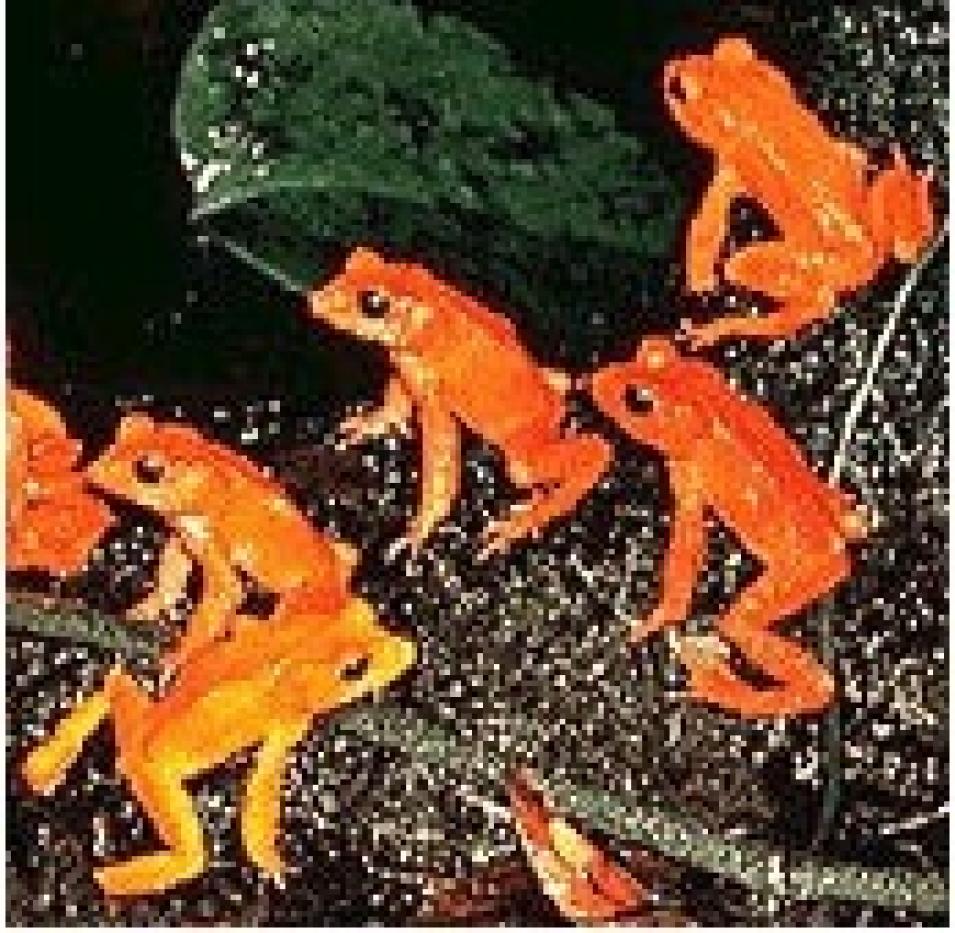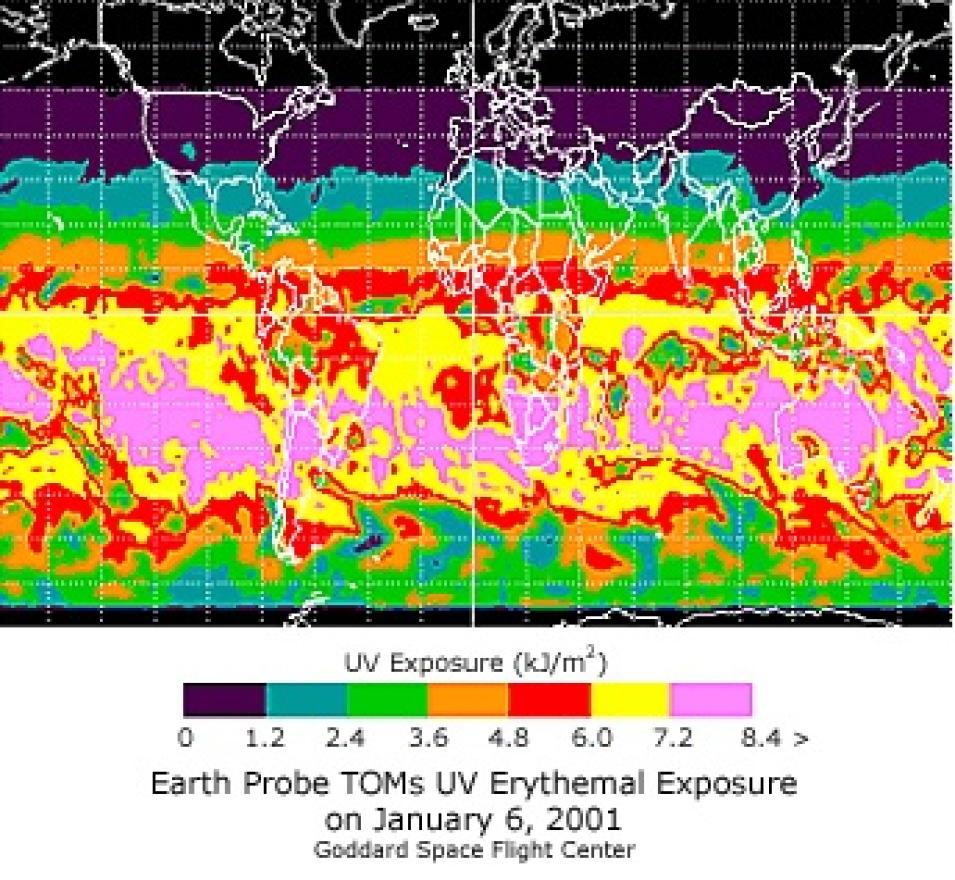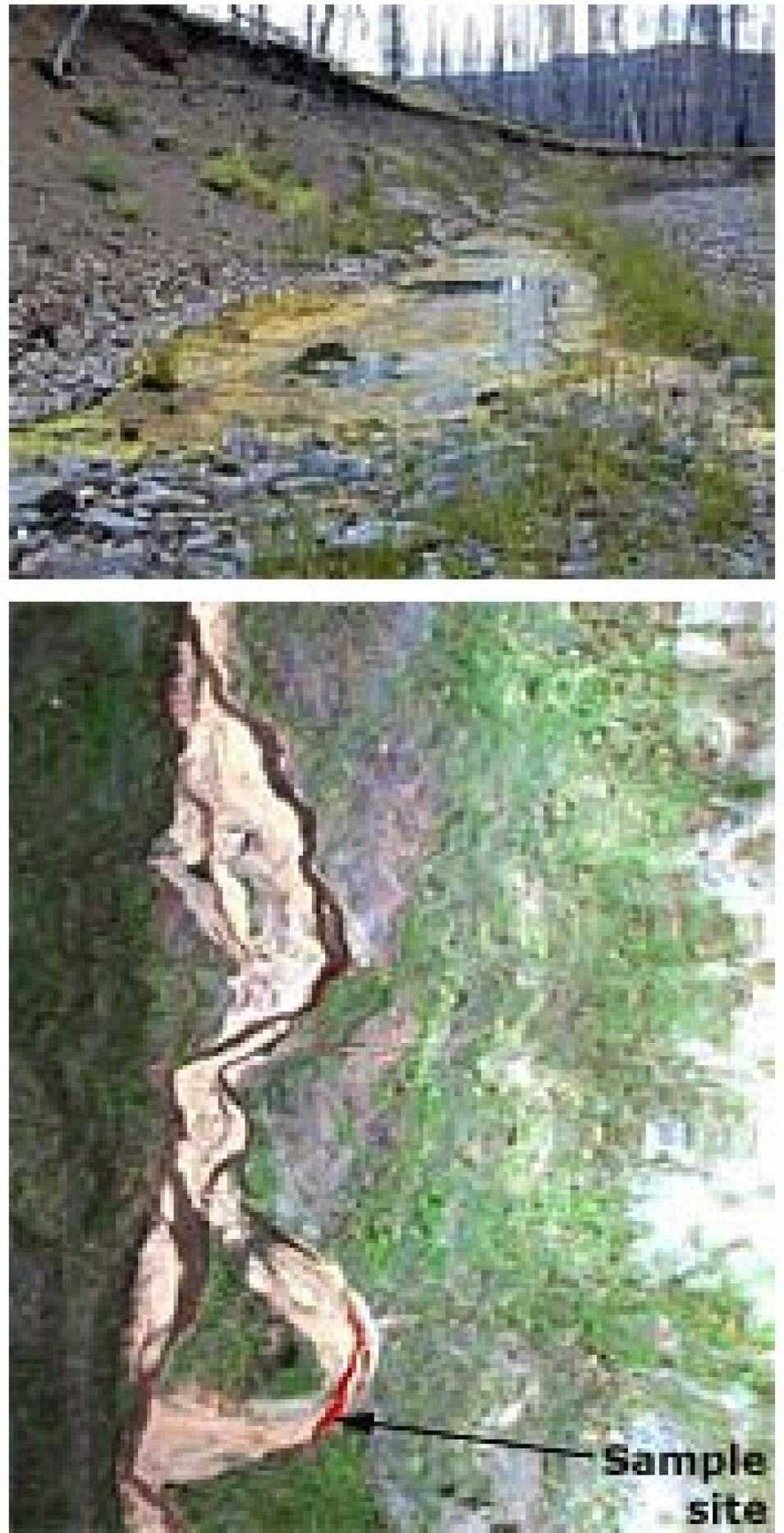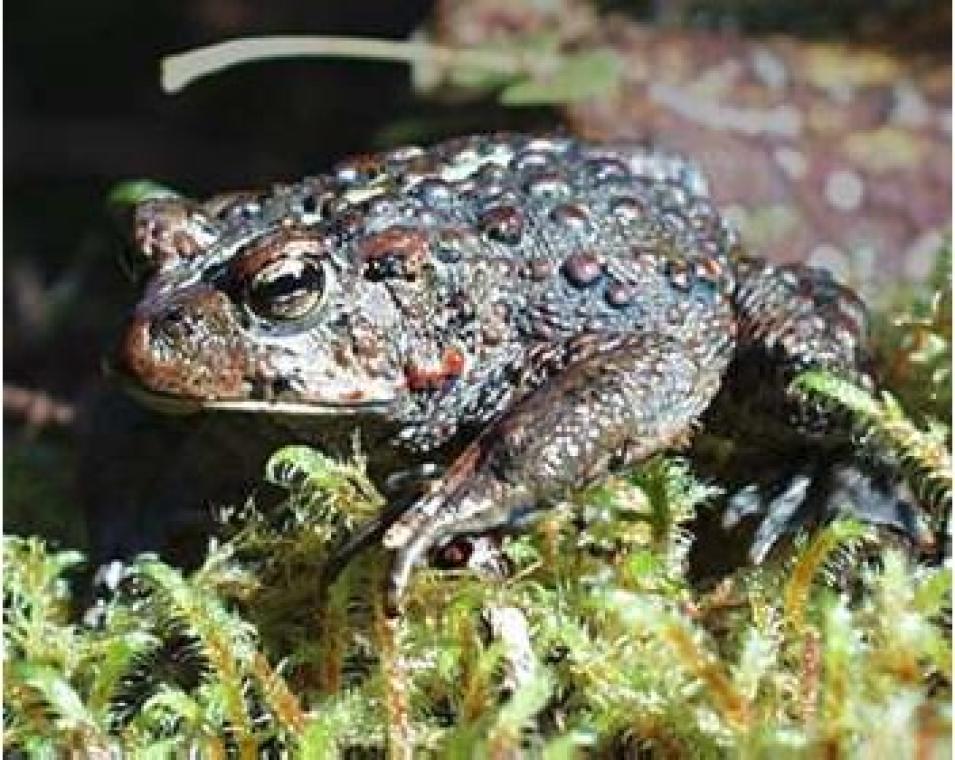In the 1970s, Cynthia Carey was studying a population of boreal toads in the Colorado Rocky Mountains for her Ph.D. thesis when the unthinkable happened: all the toads in her study mysteriously died. Carey suspected a pathogen, perhaps bacterial, but had no way to verify her hypothesis. In the late 1980s, amphibian population declines gained widespread attention as a growing number of researchers observed similar problems. When they returned to once-thriving frog habitats, the familiar amphibians were gone. Concern deepened in 1995 when Minnesota schoolchildren visited a local frog pond to discover alarming deformities in leopard frogs.
Where Frogs Live
A group of golden toads from Costa Rica. This species is now believed to be extinct. (Images courtesy of the U.S. Global Change Research Program).
Amphibian deformities have now been reported in over 30 states, as well as Canada. At present, more than a dozen amphibian species are on the U.S. threatened and endangered list, and the Las Vegas frog is believed extinct. And the problem is not limited to North America. The golden toad of Costa Rica and several species of Australian amphibians, including two species of gastric brooding frogs, are also presumed extinct.
Why are frogs in peril? In fact, no single culprit deserves all the blame, and many biologists maintain that population declines and frog deformities are not necessarily related.
Over the last two decades, herpetologists have gradually pieced together a complicated puzzle. In North America, habitat destruction and introduced species have stressed amphibian populations, while pesticides, exposure to ultraviolet (UV) radiation, and parasitic worms are also suspects. Yet amphibians are dying in other parts of the world — such as in still-untouched regions of tropical rainforest — where most of these factors are less pervasive.
Tadpoles of the boreal toad (Bufo boreas) above and the spotted frog (Rana pretiosa) below. (Images courtesy of the USGS Patuxent Wildlife Research Center).
By the late 1990s an international team of scientists had announced that a chytrid fungus was killing frogs; subsequent experiments on laboratory specimens confirmed the fungus as the killer. Carey, now a biology professor at the University of Colorado, believes the same fungus wiped out her boreal toad population in the 1970s, though she can't be certain.
"The first time smallpox was introduced to the New World, it wiped out everyone. A strain is most virulent the first time it occurs, so if a pathogen wipes out a population, it's reasonable to assume the pathogen is new," Carey says. "In the 1970s, we lost 85 to 95 percent of all Colorado frog and toad populations at high altitudes. If you estimate how long it would take for populations to come back from that kind of a mass mortality, the answer is: several hundred years, so it has probably been several hundred years since this happened last. If the chytrid fungus was here in the 1970s, it either went away or went into a non-lethal state." What Carey does know is that the chytrid fungus has menaced Colorado boreal toads since 1996.
The chytrid fungus was previously known to affect plants and insects. Why it has turned lethal for amphibians remains a mystery. Biologists have concluded that the fungus now has an appetite for keratin. In tadpoles, keratin turns up only in mouth parts, but when infected tadpoles metamorphose into frogs, they sicken and die. Theories differ as to exactly how the chytrid fungus kills frogs. Some researchers suspect it secretes a toxin while others think it simply blocks the absorption of water. "Now that we know the chytrid fungus is the cause, it isn't any less frightening," says Carey. "We know what it is, but we can't stop it."
Metamorphs retain some tadpole characteristics mixed with adult frog characteristics. (Images courtesy of the USGS Midcontinent Ecological Science Center.
With help from a NASA grant, Carey has begun incorporating remote sensing into her research, examining Total Ozone Mapping Spectrometer (TOMS) satellite data to determine ultraviolet radiation. TOMS data provide long-term daily mapping of Earth's atmospheric ozone, aerosols, reflectivity, and ultraviolet radiation. Ultraviolet radiation consists of three kinds: UV-A, UV-B, and UV-C. Of these, UV-B is the most dangerous kind that can reach ground level. Thinning ozone elevates the level of UV-B radiation and increases the risk of DNA damage in living organisms.
Carey also looked for changes in climate, temperature, and precipitation at her research sites over the past two decades.
Have environmental factors made amphibians more susceptible to pathogens?
"We have nasty things on our skin all the time — staph, strep, and so on." Carey says. "When we are immunosuppressed, we get sick. Frogs don't appear to be suffering from traditional immunosuppression. If that were the case, we would see other diseases that aren't there; the chytrid fungus seems to work without the frog's immune system even being aware of it. But if you consider the skin alone, the frog could be immunosuppressed, and this could be due to pollutants or UV radiation," she says. Carey doubts, however, that global warming plays a role. "When frogs die due to temperature, it's because they're too cold."
As more amphibian species appear on endangered lists, the need for reliable population surveys has become more apparent. To find a frog, you must figure out where it lives. Bob Crabtree, of Yellowstone Ecosystem Studies, realized researchers could use hyperspectral mapping to study stream environments. With funding from NASA's EOCAP-Hyperspectral program, he has begun a successful project for mapping riparian environments.
Erythemal UV exposure measured in kilojules per square meter. (A kilojule is equal to 0.2388 calories.) This and other TOMS measurements are available online through the TOMS Web site. TOMS data are also available on CD-ROM through the Goddard Space Flight Center's TOMS Data Set Web site.
Herpetologist Chuck Peterson, a biology professor at Idaho State University, had been conducting amphibian surveys for the USGS Amphibian Research and Monitoring Initiative and the National Park Service when he began working with Yellowstone Ecosystem Studies. Peterson attended a training session on the project and realized that the technology might be useful in conducting amphibian surveys.
Whereas humans only see three bands of light, the hyperspectral instrument used in Yellowstone detects 128 bands enabling the instrument to determine subtle landscape differences and pinpoint frog habitats with surprising accuracy. Toads in Yellowstone often breed in pools filled with algae. They have also been found in wetlands populated by sedges, or tufted marsh plants. To acquire the needed imagery, researchers mounted a Probe1 sensor on an airplane flying at about 6,000 feet (approximately 1,800 meters) above the ground, and also took a more experimental approach of mounting the sensor on a helicopter for finer resolution images. The aircraft flew over the Lamar River, Soda Butte Creek, and Cache Creek in Yellowstone National Park.
Acquiring the imagery, however, was only part of the process. For the survey to work, it had to be combined with ground observations.
Peterson visited Yellowstone in 1999, concentrating on Cache Creek. While others gathered ecosystem data through hand-held and airborne spectrometers, Peterson looked for frogs. Both the spotted frog and the boreal toad live in Yellowstone but because the boreal toad is at greater risk, Peterson focused most of his energy on locating that species. He combined his observations with the hyperspectral imagery and, the following summer, met with Andrew Marcus, an associate professor of geography at Montana State University.
Peterson pointed out frog habitats and the pair selected one algal and one sedge wetland site as search templates for the study area. Using Environment for Visualizing Images (ENVI) software written by co-investigator Joe Boardman, they then located similar sites.
"For the algal sites, we used 1-meter scale imagery," says Marcus. "Algae accumulates in small areas, and 1-meter imagery provides fine-scale detail that other imagery cannot provide."
For the sedge wetland sites, 3- to 5-meter data worked best, although Peterson had initial doubts. "It looked to me like we were over-predicting on the sedge wetland sites," he says. "Actually, we tried to over-predict a little, to make sure we didn't miss anything. But I thought the sedge wetland imagery was over-predicting too much."
In fact, it wasn't. The 5-meter data predicted sedge wetland sites with 100 percent accuracy. "There were more sedge wetland areas than I thought. And unless you were willing to walk on both sides of the canyon, hundreds of meters away from the stream, you wouldn't have known those sites were there," Peterson says.
Predictions of algal ponds proved slightly less accurate. Of the 16 algal sites predicted by the imagery, four had no algae, though one of those four turned out to be a frog habitat after all. But not every algal pool is a frog breeding site. Peterson says, "We've been able to play with the imagery and can get rid of those over-predictions now that we know a little more about it."
"The lack of this kind of fine-scale habitat data is the single biggest limitation of using GIS (Geographic Information Systems) to design amphibian surveys. So the results of the hyperspectral analysis are really promising," says Peterson. Each area surveyed by the hyperspectral mapper was 20 to 30 miles (approximately 30 to 50 kilometers) long, covering terrain that can be difficult to traverse on foot. "We're not able to visit all the frog habitats in Yellowstone, much less the intermountain west, so we can extrapolate some of our work to places we can't reach," he says.
The possibilities of hyperspectral mapping don't stop with surveys. "Not only does this let us extrapolate to other areas, but it will also support modeling to predict the consequences of habitat change, such as fires or development" says Peterson.
In addition to locating new breeding sites, amphibian research in the Yellowstone area has revealed some unwelcome news. Debra Patla, one of Peterson's research associates, has collected toads in Jackson Hole, Wyoming that have tested positive for the Chytrid fungus. This is the first report of the disease in the northwest Wyoming. Whether this discovery signals an impending wave of toad population losses in Yellowstone and the Teton Range similar to those in Colorado remains unknown.
Cautious about spreading the chytrid fungus between populations, Peterson and his research assistants wash their boots and equipment in bleach solution before visiting new sites, but Peterson points out that introduced species also present a problem. "When I moved out West, I expected to find lots of pristine landscapes," he says, "but it's not like that. People have stocked nearly all the deep high mountain lakes with trout." Introduced fish may carry pathogens on their bodies that can infect amphibians, and the stocked trout prey on amphibians, reducing their ability to reproduce. "One of the biggest problems is humans moving alien species from place to place."
Yet Peterson, along with many other biologists, believes the frogs' biggest problem may be loss of habitat. "Here in Idaho, we've lost 55 percent of our wetland habitat, and we're a relatively undeveloped state. These amphibian populations get broken up and isolated from each other, and then they're more likely to go extinct."
Ancestors of modern frogs evolved during the Jurassic, and this group of amphibians has inhabited Earth for 190 million years, surviving the K-T extinction that wiped out the dinosaurs. Frogs' sudden failure to thrive suggests a significant ecosystem change. "I think similar problems are happening in other organisms," says Peterson. "I work with reptiles, too, but they're much harder to study than amphibians. They don't all get together in a pool to breed. They don't call. You can't look into a pool and see their larvae. Amphibians are probably more susceptible to changes in the environment, but equally important is the fact that you can see what's happening to them. Amphibians are often a good indicator of ecosystem health."
References
Carey, Cynthia, W. Ronald Heyer, John Wilkinson, Ross A. Alford, J. W. Arntzen, Tim Halliday, Laura Hungerford, Karen R. Lips, Elizabeth M. Middleton, Stan A. Orchard, and A. Stanley Rand. 2001. Amphibian Declines and Environmental Change: Use of Remote-Sensing Data to Identify Environmental Correlates. Conservation Biology.Vol. 15, No. 4.
For more information
NASA Goddard Earth Sciences Data and Information Services Center (GES DISC)
U.S. Geological Survey (USGS) FrogWeb
USGS Amphibian Research and Monitoring Initiative
The Exploratorium's Frogs Exhibit
| About the remote sensing data used | ||
|---|---|---|
| Satellite | TOMS ENVI GIS | |
| Sensor | ||
| Parameter | hyperspectral mapping of amphibian populations | |
| DAAC | NASA Goddard Earth Sciences Data and Information Services Center (GES DISC) | |





